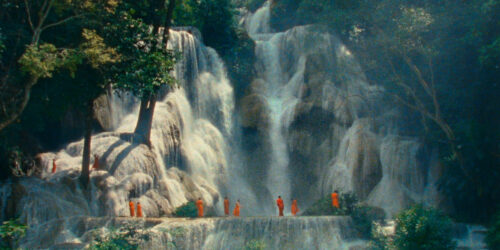Samsara
Date: Thursday June 27th 2024
Location: TIFF Lightbox
The Senses and The Screen
By Aidan Cseh
To view Samsara is to feel the extent of one’s senses. In the film, The Tibetan Book of the Dead informs the philosophy of Amid and the Monks of the Laos temple, who live by orienting their perspective with the experience of the body and senses. They use their physical placement within the world to retain empathy for all that surrounds them, looking at a tree in the same way you would a person. The film merges this philosophy with the spectator’s perception, carrying over the material empathy of experience to that of the screen. One such moment occurs when Amid and the monks are traversing a waterfall, and gesturing towards a tree they wonder about its pain. The tree is framed by blue water and the vibrant leaves of trees, and as they look towards it, so does the camera – so do we. The philosophical questions to imagine yourself in the tree’s place are spoken to Amid, and consequently the spectator as well, allowing one to feel connected to the tree beyond the boundary of the frame. The distance of the image is bridged, and there is overlap between the camera’s perspective and ours. It’s moments like these, when the images of the screen converge with those of the characters, that empathetic experience prevails over narrative.
The narrative that is within the film is minimal, whispering poetic and philosophical questions of being and death out of its landscapes rather than creating illustrative portraits of characters. ‘Would you envy your body in the afterlife, wishing you had your senses and ability to experience back’ is a question that applies both to the older lady on her deathbed and the viewer: the viewer now more than ever feels the air that breezes through the theater and sees the glow of the screen illuminating the walls. As the older lady who Amid has been guiding towards reincarnation dies, images of a river, sketches on the wall, and Amid overlay, materializing the buddhist philosophy of connection into the form, extending the empathetic gaze of the camera to the viewer. The overlay of two or three images functions to draw connections across spaces, demonstrating through experience the sensorial effects of interconnectivity and death. For a moment everything is connected and the body is grounded by stillness. Amid speaks to the older lady stating that when she dies, it is her body and senses she would miss the most – the experience of living.
After the older lady dies, the viewer is asked to close their eyes and see the light against their darkened eyelids. A meditative journey begins, where in the context of the minimal narrative, represents the older lady’s journey between bodies, when the senses are detached from the self. For the viewer, the guided meditation grounds us into the theater, extending the appreciation for the beauty of seeing and feeling into the experience of living. The soundtrack begins as ambience, allowing the viewer to focus on the colors that flicker on the screen and illuminate the texture of the eyelids. As the audio transitions toward the sounds of muffled voices and children’s laughter the mind begins to formulate images of people and places rather than an abstract awareness of feelings. Naturally the meditation transitions you from one state to another as you follow the path of reincarnation towards a new body, when you feel your senses creating your experience. The potential of Buddhist philosophy in film is realized, in which connection to our senses is formed through our experience of the medium. The implied change of state is encapsulated by the older lady’s reincarnation into the body of a goat; a choice in the narrative that changes subject and space, re-orienting the story onto a family in Zanzibar. The goat acts as a window into their lives, specifically their place within their community, and how the function of the body within labor and community is adapting to modernity.
As we follow the goat and the family that takes care of her, the film gestures towards the ways in which bodily labor is being placed secondary to mechanical process. The appreciation for the use of the body as a person’s primary engagement with the world becomes contrasted by the introduction of soap-making machinery. Earlier in the film, technology is present in the form of cellphones that the Buddhist monks use to take photos and share music with one another. The film doesn’t lampoon the idea of technology within the communities depicted, instead contrasting its interconnective benefits with the increasing feeling that the body is progressively lacking use. The film acts in opposition to this symptom of modernity, drawing the viewer in from a distance with slow, ambient pacing, using their own body, their own senses and feelings to relate to the subjects.
